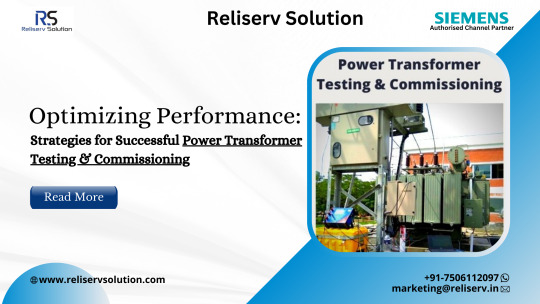#GridPerformance
Explore tagged Tumblr posts
Text

"Transforming potential into power, one test at a time - at Omnific Solutions, we're the current champions of Substation testing and commissioning in MIDC Koperkhairne, Navi Mumbai!" @omnificsolution
#OmnificTransformers#SubstationTesting#CommissioningExperts#TransformerTesting#MIDCKoperkhairne#NaviMumbaiEngineering#PowerGridSolutions#ElectricalTesting#ReliabilityTesting#QualityAssurance#TransformerMaintenance#EnergyEfficiency#GridSolutions#AdvancedTestingMethods#PowerInfrastructure#EngineeringExcellence#TransformingPower#ElectricalSafety#GridPerformance#innovationinpower
0 notes
Text
Optimizing Performance: Strategies for Successful Power Transformer Testing & Commissioning

Power transformers are the silent giants that form the backbone of electrical distribution networks. Ensuring their optimal performance is not just a matter of reliability but a critical component of maintaining the integrity and efficiency of the entire power system. The journey of a power transformer from installation to full operation involves meticulous testing and commissioning processes. This blog unravels the strategies and best practices essential for the successful testing and commissioning of power transformers, emphasizing the significance of this phase in optimizing overall performance.
The Vital Role of Power Transformers
Power transformers serve as the linchpin in the transmission and distribution of electrical energy. From stepping up voltages for efficient long-distance transmission to stepping down voltages for safe distribution to end-users, transformers play a crucial role in the power grid. The success of the entire power system depends on the reliability and efficiency of these transformers.
Our team of professionals provides all types of transformer testing and commissioning. We operate at all voltage ranges, including MV, EHV, HV, and LV. In addition, we handle ETC for GIS and AIS substations. We take great pride in having our cutting-edge testing apparatus so that we can rapidly complete the task on our own and do the essential testing of the transformers.
Unveiling the Strategies for Successful Testing & Commissioning
Thorough Pre-Commissioning Inspection: Before the testing process begins, a comprehensive pre-commissioning inspection is paramount. This involves a meticulous review of the transformer's construction, ensuring that all components are in place and meet design specifications. Visual inspections, oil and insulation checks, and examination of auxiliary systems are integral to this phase.
Functional Testing of Components: Each component of a power transformer must undergo functional testing to validate its individual performance. This includes tests on bushings, tap changers, cooling systems, and protective devices. Verifying the functionality of these components ensures that the transformer is equipped to handle various operating conditions.
Dielectric Testing: Dielectric tests are critical for assessing the insulation integrity of a transformer. Power transformers operate at high voltages, and ensuring the dielectric strength of insulation materials is crucial to prevent breakdowns. Common dielectric tests include the power factor test, dielectric absorption test, and insulation resistance test.
Ratio and Polarity Tests: The ratio and polarity tests are fundamental to confirm that the transformer windings are configured correctly. Any discrepancies in the turns ratio or polarity could lead to improper voltage transformation, affecting the overall performance of the transformer. Precision in these tests is vital to guarantee accurate voltage regulation.
Winding Resistance Measurement: Winding resistance measurements provide insights into the health of transformer windings and connections. Deviations from expected values could indicate issues such as loose connections or high-resistance joints. Addressing these concerns during the testing phase prevents potential failures during operation.
Oil Quality Analysis: For oil-immersed transformers, the condition of the insulating oil is a critical factor. Routine oil quality analysis assesses parameters such as moisture content, acidity, and the presence of contaminants. Clean and well-maintained oil contributes to enhanced insulation and cooling performance.
Insulation Resistance Measurement: Insulation resistance is a key parameter for evaluating the insulation condition of a transformer. Insulation resistance measurements help identify any leakage paths or insulation degradation. This test is particularly crucial for detecting issues such as moisture ingress or insulation aging.
Dynamic Short Circuit Withstand Test: The dynamic short circuit withstands test simulates the transformer's response to short-circuit conditions. This test evaluates the mechanical and thermal stability of the transformer under high-stress scenarios. Successful performance in this test ensures that the transformer can withstand fault conditions without catastrophic failure.
Temperature Rise Test: The temperature rise test assesses the thermal performance of a transformer under normal operating conditions. By measuring the temperature rise of key components during full-load operation, this test verifies that the transformer can dissipate heat effectively and avoids excessive temperature levels that could compromise insulation life.
Commissioning with Load: Commissioning a transformer with an actual load is the final step to validate its performance in real-world operating conditions. Monitoring parameters such as voltage regulation, load losses, and overall efficiency during commissioning provides a comprehensive assessment of the transformer's capabilities.

Elevating Transformer Performance through Testing & Commissioning
Reliability Assurance: Thorough testing and commissioning instill confidence in the reliability of a power transformer. Identifying and addressing potential issues during the testing phase mitigates the risk of unexpected failures during actual operation. This reliability assurance is fundamental for the transformer's long-term performance.
Optimal Efficiency: Efficiency is a cornerstone of power system performance, and transformers play a crucial role in energy transfer. Rigorous testing and commissioning ensure that the transformer operates at its peak efficiency, minimizing energy losses and contributing to the overall efficiency of the power grid.
Preventive Maintenance Insights: The data gathered during testing and commissioning provide valuable insights for future preventive maintenance. Understanding the transformer's performance characteristics under different conditions allows operators to develop targeted maintenance strategies, prolonging the transformer's lifespan and reducing the likelihood of unplanned outages.
Compliance with Standards: Adhering to industry standards and specifications is non-negotiable in the power sector. Testing and commissioning processes are designed to verify compliance with these standards, ensuring that the transformer meets the required performance and safety criteria. Compliance is not just a regulatory requirement but a commitment to delivering quality and reliability.
Enhanced Safety: Safety considerations are paramount in power transformer operations. Thorough testing and commissioning uncover potential safety hazards and allow for corrective measures to be implemented. This proactive approach contributes to a safer working environment for maintenance personnel and ensures that the transformer operates within established safety parameters.
Services provided for the testing and commissioning of power transformers.
Offline Testing
• Functional Checking of Protection Devices like PRV, Buchoze Relay, MOG, OTI, WTI
• Dielectric Frequency Response Analysis (DFR)
• Capacitance and Tan Delta Measurement of Transformer
• Transformer Turns Ratio Measurement Ratio
• Magnetic Balance Measurement
• Winding Resistance Measurement
• Insulation Resistance and Polarization Index Measurement
• OTI and WTI Meter Calibration
• Sweep Frequency Response Analysis Measurement
Online Testing
Partial Discharge Measurement and Localization
• Thermography
• Online moisture content Measurement
• Transformer Oil (Screening, DGA and Furan) Test
Conclusion
The journey of a power transformer from installation to full operation is a meticulous process that demands precision and attention to detail. Testing and commissioning are not merely procedural steps; they are integral to ensuring the transformer's optimal performance, reliability, and safety.
By adopting a strategic approach to testing, power utilities, and industries can elevate the performance of transformers, contributing to the overall efficiency and resilience of the power infrastructure.
As the energy landscape evolves, the role of power transformers becomes increasingly pivotal, and the success of this evolution hinges on the thoroughness of testing and commissioning practices. Please click here
#transformertesting#commissioning#powerinfrastructure#electricaltesting#gridperformance#energyefficiency#electricalengineering#utilities#transformermaintenance#powergrid#voltageregulation#testingandcommissioning#energymanagement#optimizedperformance#electricalsafety#powerquality
0 notes
Link
If you have got any queries, please feel free to call CTC Global (949) 428-8500 or e-mail your questions to [email protected] to know more about ACCC Informational Resources and Support
0 notes
Link
CTC Global’s high-capacity, high-efficiency ACCC conductors offers one of the most cost-effective means of reducing fuel consumption and associated emissions, while also increasing grid capacity to support the deployment of more clean renewable energy.
0 notes